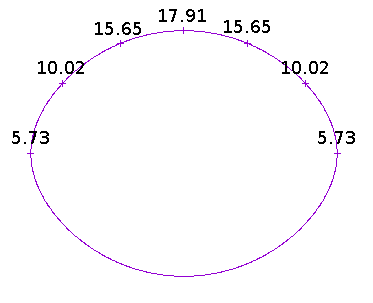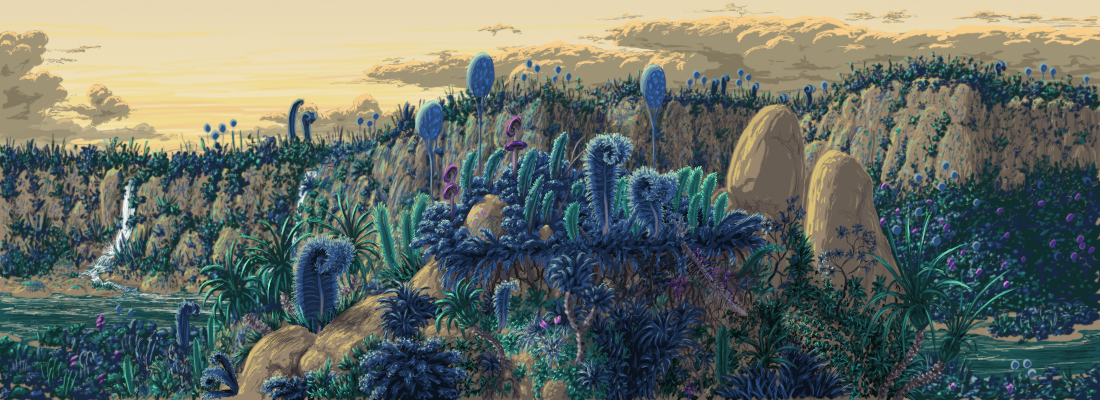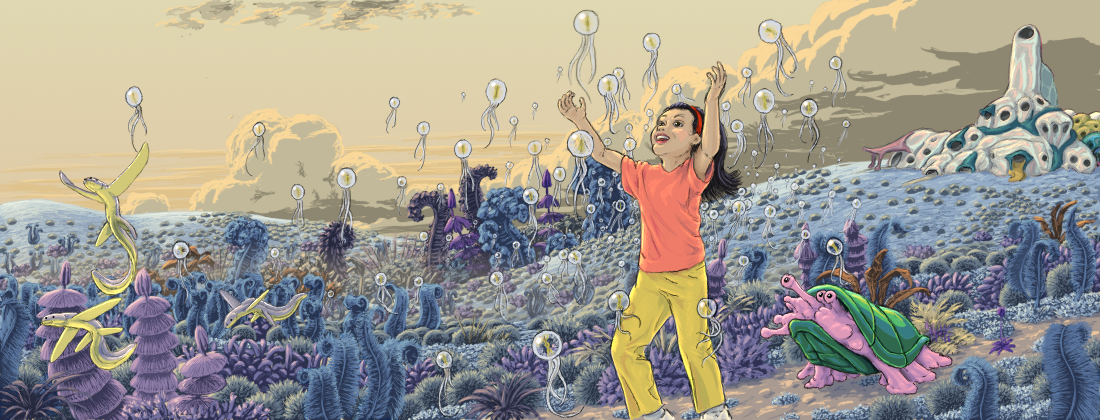| Zhiroom | |||
Natural FeaturesZhiroom is a large world that spins so fast that it is drawn out into a flying saucer shape by the centrifugal force. The centrifugal force combined with the gravitational force and varying distance from the world's center means that the felt gravity varies considerably over its surface. At the poles, the gravity is crushing, while the equatorial gravity is noticeably light. Zhiroom has two moons, a giant moon in the same class as Luna and Europa of the Sol system, and a smaller rockball moon in the larger moon's L4 Trojan point. Zhiroom has a dense atmosphere of neon, nitrogen, helium, and oxygen. Fortunately for visitors, helium and neon have nearly no narcotic effect, and the narcotic effect of nitrogen is mild – many visitors will not notice any difference. The high neon content makes the speed of sound a bit higher than typical, which makes voices sound a touch higher pitched (with the exception of Mants, who make sounds via stridulation). Unfortunately, the carbon dioxide level of Zhiroom is a touch high. Gummis do not mind, but other species feel that the air is "stuffy" and may suffer headaches, irritability, drowsiness, insomnia, and difficulty thinking straight. Most individuals are able to acclimate after several weeks, and gene surgery is available that allows greater carbon dioxide tolerance. The high level of CO2 does at least keep the planet warm given that it is relatively far from its sun. Zhiroom's thick atmosphere scatters out much of the blue and green light from the sun, letting primarily yellow, orange, and red light through. To Human eyes, the skies of Zhiroom appear to be pale pink to butterscotch in color while the sun is a sunset-orange. The yellow skies are most pronounced at the equator where the atmosphere is piled up thicker (although the pressure is the same as elsewhere). As you move toward the poles, the horizons remain a creamy yellow but the sky above gradually becomes a pale green-gray or teal-gray in clear weather. A massive world like Zhiroom will have plenty of internal heat, leading to extensive mantle convection and plate tectonics. This in turn leads to high mountains along plate boundaries, island arc and continental arc volcanism, frequent but irregular earthquakes, and interesting geology with plenty of dikes, sills, basin and range landscapes, thrust faults, rift valleys, calderas, and so on. In addition, it has a considerable level of hotspot/heat pipe volcanism, leading to large shield volcanoes. Combined with the active tectonic plate movements, this leads to many volcanic island chains. The flattening of the world and its moderate inclination means that the arctic (or antarctic) circle covers most of each hemisphere, sparing only the equatorial regions. The high Coriolis force results in many Hadley cells which hinder the transport of atmospheric heat between the hemispheres. As a result, even though the axial tilt is fairly typical for a habitable world, there are large seasonal swings over much of the planet, and the high gravity regions will be in full sunlight for half a year and then in darkness for the next half. Fortunately, the short year prevents the freezing, lightless winter from being too long. The equatorial regions are much more clement, and at around the 9 – 10 m/s² (0.9 – 1 g) latitude lines, the climate is comfortably temperate. Zhiroom's weather is influenced by the high rate of rotation and consequent high Coriolis forces. Cyclonic storms (hurricanes) are frequent but small. Tornadoes are also frequent, but strong. The dense atmosphere results in a deep troposphere, resulting in weather systems over a wide range of altitudes and a lot of room for truly towering storm systems to develop. Summer in the temperate and polar regions, and regularly throughout the year in equatorial regions, often sees severe storms with multiple tornadoes, high winds, drenching rain, and frequent lightning. Zhiroom has an active biosphere, from squat lumps covered with photosynthesizing lichen-like crud at the poles to spindly "trees" with feathery leaves near the equator. The dominant photopigments on Zhiroom range from cyan at the equator through blue in mid-gravity regions and purple near the poles. High gravity regions often feature "rope flora" - tangled masses of liquid containing tubes sprawled across the landscape. Balloon trees are common. By pumping the atmosphere's helium into a gas bag, and the other gases out, it can produce substantial lift in the dense atmosphere. A tether holds it in place for the majority of its life cycle, but many varieties let their balloons break loose to distribute their seeds far and wide. A few species even make a living untethered, forever floating high above the ground. Evolution has also provided Zhiroom with a rich variety of animal life. The dense atmosphere makes winged flight easier, if slower. Many lineages of animal have evolved to have at least limited powered flight, while some are dedicated aerealists. Basic take-off is acheivable with much smaller wings, although specialized fliers tend to develop wings similar in proportion to those of Earth birds and bats. These specialized fliers often have adapted for increased body density, or behaviors such as swallowing stones, in order to increase their weight – and thus flight speed – because take-off with large wings and strong wing muscles in the dense atmosphere is not an issue. Similarly, many animals are balloonists, floating with gas bags similar to those of the balloon trees. With all this ease of flight, air plankton often bloom in vast teal clouds leading to an entire ecology of air filter feeders. Gummiland life adapts well to the conditions of Zhiroom, particularly in the moderate gravity areas, and many species are now established and invasive.
A Zhiroom field guide.
Slitherbees and cats-eye globes attempt to make an escape from two rampaging alien invading monsters.
HistoryThe last major world explored and colonized before The Bump in the Night, Zhiroom was attractive to Gummis for its comfortable environment. Although it started out with a reasonable seed population, the difficulties following the Verge's isolation limited its growth for a gigasecond or two. Now that Verge society is back on a solid footing, Zhiroom is beginning to see increased growth and development.
GovernmentAs typical of a Gummi dominated world, there is not much of a government to speak of. Local coordination committees of civic-minded citizens suggest voluntary guidelines, which are in turn given suggestions by the global Zhiroom coordination committee.
EconomyZhiroom is largely agricultural, growing Gummiland crops and exporting native spices and intoxicants. Recently, it has attracted investment from biotech and medical firms.
PeopleThe population of Zhiroom is mostly Gummis. A significant Pirang minority is present, and some Tweechi flocks have settled on the planet. The equatorial regions are popular vacation spots for Tweechi visitors.
Places
UuniinleeThe main city and wormhole terminus of Uuniinlee has experienced a recent boom due to the re-location and development of several biotech and med-tech Nogis to the region. Its wormhole station is still a basic, small town affair and will likely need to be expanded soon to allow for the increase in traffic. Uuniinlee is located where the local gravity is 13.2 m/s² (1.3 g). The environment is lightly forested, although the non-ballooning trees are short, thick, and stout. Uuniinlee has a small but growing Gummiland style land reef, which is a popular recreational park.
|


